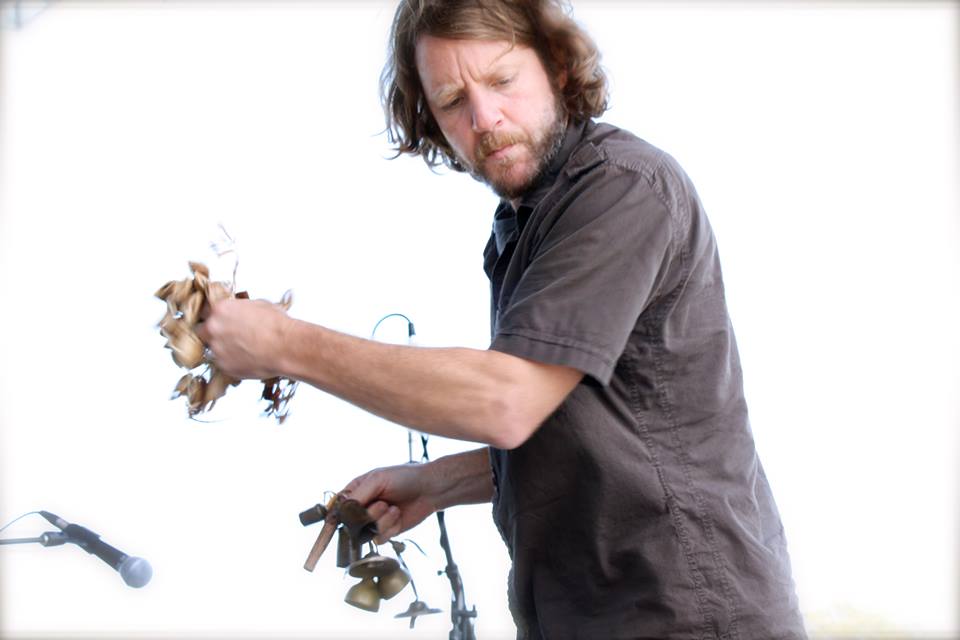
Medeski Martin & Wood have been taking their avant-garde act around the globe for 25 years, and from New Orleans to London, drummer Billy Martin has found time to fill hotel stationary with his improvised drawings. To call them “doodles” would be an injustice akin to using “noodles” to describe a guitarist’s wandering licks. Martin prefers to call his art “improvised” or “automatic” drawings. Projected onto the walls of the Drawing Center, a pristine SoHo art gallery, Martin’s drawings took on new meaning.
As part of his ‘Wandering’ series, which ran July 8-10, Martin invited friends with varying music pedigrees to interpret his drawings as “graphic scores.” For three nights, the gallery was packed with guests sitting “loft-style” on the floor, observing and hearing Martin’s medium of choice: rhythm. Although he’s had musicians interpret artwork before, Martin said he considers the exhibition a “milestone” in his career.
On the first night, members of Alarm Will Sound, a 20-piece chamber orchestra, played a piece conducted by Martin which will appear on Medeski Martin & Wood’s forthcoming album. The live record, which the band recorded with the full Alarm Will Sound ensemble in February in Boulder, CO, should be released by the end of 2015, Martin said.
Later, after a far-out electronic improvisation by MMW bandmate John Medeski and a dark, brooding soundscape from guitarist Chris Cochrane, Martin sat behind his kit to interpret one of his own drawings. He tapped and thrashed, at first with straw broom heads, and later with brushes and sticks, completely in tune with himself and the drawing on the wall. “It’s like playing with someone. You look at an image, you just try to be in the moment,” Martin said. “Every moment you’re in is different, so you may feel differently the next time you look at it.”
In the adjacent room behind his elaborate percussion setup, a smaller gallery showcased Martin’s drawings, and several notations from his rhythmic improv game, “Stridulations for the Good Luck Feast.” The players of the game can play any of the noted rhythms at any tempo at any time, with the aim of creating a stridulation, which sounds like the layered ambiance of many crickets. This may seem chaotic, but it was sonically coherent on the second night of the exhibition, when Martin led a group of 20 percussionists through a dynamic, improvised stridulation to begin the evening.
The 15-minute duet with Martin and modern dancer Yoshiko Chuma that followed the stridulation was arguably the most spirited performance of the series. Chuma pranced around deliberately, while Martin started the segment on mini gongs. By the time he got behind his drums and began a solo, Chuma had twirled her way behind the MMW drummer, draping her arms around his shoulders as he smashed the skins and choked his crash cymbal. She danced out from behind the drum kit, pumping up the seated audience with her arms. The crowd stirred into a roar as Martin flailed around the drums, his eyes trained on Chuma, who urged him to carry on. Surely, it was the loudest spectacle in the Drawing Center’s history.
Martin is in his prime during this type of free-form improvisation. Of the hundreds of percussion solos he has taken over the years with Medeski Martin & Wood, each is remarkably unique. “That’s what keeps you alive,” he said. “Otherwise, you’re just playing things that you did before – that you thought of before – and it’s not really true improvising.”
When there is music to improvise within, it helps to know the structure. Despite being a world-class improviser, Martin still struggled when Phil Lesh invited him out to Terrapin Crossroads for two shows in April. “I flew in the night before, I got the setlist and I hadn’t heard 95 percent of the music ever in my life,” said Martin. “It was hard. I mean, a drummer in Phil Lesh’s band, he’s got to know what’s going on.”
The Rolling Stones’ “Sympathy For The Devil” was one of the few tunes Martin knew by heart. After a drum solo introduction, he kicked into a latin-flavored groove which brought new life to the classic song. Martin said Lesh loved his playing on that number. In the video below, you can see Phil gives Martin a fist bump of approval after the song concludes.
Back in New York, both of the first two shows in the ‘Wandering’ series ended with a song structure Martin was more intimate with: “Heart Strings,” an original arrangement which features certain instruments playing a composed structure, while others improvise. At the end of the second concert, with Cyro Baptista playing percussion, Anthony Coleman on keys, and more than a dozen instruments playing harmoniously, Martin laid down a slinky beat for a few minutes before handing his sticks to a former student, and conducting the ensemble.
“When I compose, I really don’t know what the hell I’m doing,” Martin admitted to the audience early in the series. But, “Heart Strings” seemed to hold a special place with hum as he described its origins to the audience. The arrangement was first performed with a “scentstallation” created by Billy’s wife, perfumer Phaedra Holt Martin. She created the perfume to help relieve her husband’s heart palpitations and subsequent anxiety.
Phaedra created a couple new scents for the special three-night exhibition at The Drawing Center, but Billy still wears the original perfume every day. These scents were among the first noticeable features as one moved throughout the gallery. In the basement, where Martin’s heady short film ‘Chaman’ looped continuously, a different scent filled the air than the one upstairs. Phaedra said the Martin house smells “even better.”
Martin’s ‘Wandering’ series sat somewhere near the intersection of sound, sight and smell. He invited the observers to meet him out there at that abstract place, so long as their wandering minds agreed to take them there.


No Comments comments associated with this post